
Honda HR-V 4x4 (2015-2020) engines, drive and performance
.jpg)
Three different engines are available, with two petrols and one diesel. The diesel and entry-level petrol engines provide an adequate level of Honda HR-V performance, although the focus for both is on efficiency rather than outright speed.
Familiar diesel option
We’re already fans of the supremely smooth 1.6-litre i-DTEC diesel engine found in the Honda HR-V, following its sterling service in both the larger CR-V as well as the more conventional Civic range.
While 120hp doesn’t sound particularly appetite-whetting, the 300Nm of torque it delivers to the front wheels from 2,000rpm is satisfying enough. Top speed is 117mph.
It’s no ball of fire, with the sprint from 0-62mph taking between 10-10.5 seconds, depending on trim level (the lowest grade S being the quickest), but it feels the more capable compared with the equivalent 1.5-litre petrol on offer.
Its muscular power delivery seems to make more sense here, making lighter work of overtaking and sounding less strained as it gets up to speed.
.jpg)
Two petrol engines
Honda believes a significant proportion of HR-V buyers will not cover the kind of distances or drive the journey types that suit diesels better, so a 1.5-litre i-VTEC petrol is on offer, too.
Although it produces 130hp, peak torque’s only 155Nm, meaning you have to work the engine hard to access it, as it’s not available until 4,600rpm. The problem is, when you do, the motor sounds noisy and shrill, and if you need a sudden burst of forward motion, you’ll be regularly swapping ratios on the standard six-speed manual gearbox to extract the performance.
Its on-paper numbers suggest it’s similar to the diesel in performance, with a slightly higher top speed of 119mph and a 0-62mph time taking between 10.2 and 10.7 seconds depending on trim. In reality, it won’t feel like this is the case.
Powerful 1.5-litre turbocharged petrol joined in 2019
An additional engine was introduced to the HR-V range in 2019. With the help of a turbocharger, this boosted performance to 182hp and torque up to 240Nm, dropping the 0-62mph time to 7.8 seconds. Top speed jumps up to 134mph.
The turbocharged nature of this engine answers for the entry-level version’s lack of muscle, with a broad spread of mid-range torque. Performance is eager and makes for a fun HR-V to drive, regardless of whether you want to use all the performance or not.
You don’t have to wait too long for the turbo to help gain momentum and the power delivery isn’t too abrupt. It certainly feels quick, but you can simply cruise in a higher gear should you wish ro a more relaxed driving experience
Automatic gearbox available on petrol engines
You can opt for the CVT automatic gearbox on all petrol engines above entry-level S spec. It comes with seven artificial gears, but performance drops off a little, with the lower-powered versions reaching 116mph, and 0-62mph times rising to 10.9 seconds for the SE models, 11.4 seconds for the flagship EX trim.
.jpg)
The 1.5-litre turbocharged engine sees the top speed drop down to 124mph, and the 0-62mph time rise to 8.6 seconds.
Due to the nature of the CVT gearbox, we suspect the performance of these will feel slower than what the figures already suggest, and also result in a far less relaxed experience as the engine constantly spins away at a higher speed during acceleration.
The six-speed manual gearbox is one of the best we’ve used in a sensible family car – it has a short throw and a short, stubby gearlever that falls perfectly to hand.
.jpg)
It feels at odds with the rest of the controls, which are notable for feeling the opposite of sporty and engaging, but this hardly a complaint.
Handling – Is it any good to drive?
It is – but that’s all relative when it comes to sensible family cars. The steering is typical of an SUV – feeling anaesthetised, communicating very little about the levels of grip the front tyres are experiencing. There’s little weighting on the move and it’s too light for drivers to feel involved, should they wish to indulge in some spirited driving. The flipside is that it’s light enough for easy manoeuvring.
In typical crossover fashion, the Honda HR-V handles neither like a small SUV or a coupe, which given that it’s neither of those things in reality is no surprise.
Of course, it’s unlikely this Honda will prove to be a car you get into simply for the joy of driving – manual gearbox aside – but the HR-V remains one of the better small crossovers to drive.
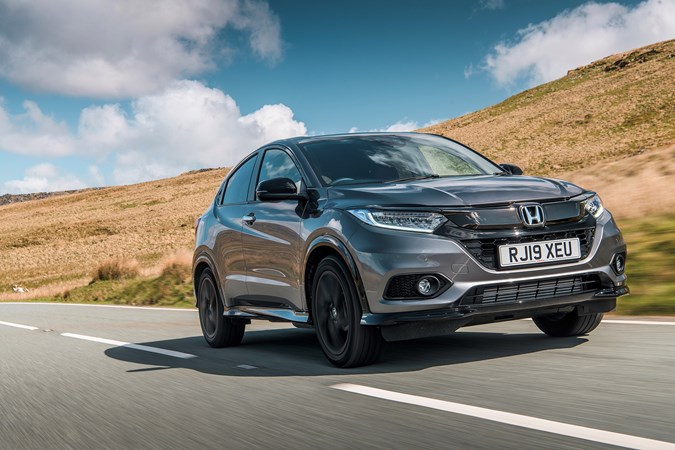
The HR-V corners and goes where you’d expect it to, with the front tyres pushing out wide when provoked. Given its short length compared to the likes of the Qashqai, it feels lighter and more nimble too, delivering a neat repertoire of handling characteristics – there’s a bit of body roll to contend with, which is expected, but it remains composed.
The Sport comes with tweaked suspension to improve agility, but the end result is hardly a transformation, you certainly won’t be fooled into thinking this is a Civic.
You’ll still encounter a degree of body roll, but the suspension manages to prop it up well.
The pedals are responsive to use, but the clutch biting point on the petrol models can be a little tricky to detect, meaning you either over-rev the engine or spin up the front wheels as you set off from stationary. The short travel pedal doesn’t help, but the HR-V remains easy to drive, with strong braking performance.


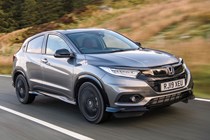
.jpg)
.jpg)
.jpg)
.jpg)
.jpg)
.jpg)
.jpg)
.jpg)
.jpg)
.jpg)
.jpg)
.jpg)
.jpg)
.jpg)
.jpg)
.jpg)
.jpg)
.jpg)
.jpg)
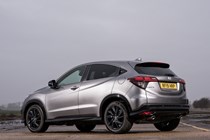

.jpg)
.jpg)
.jpg)
.jpg)
.jpg)
.jpg)
.jpg)
.jpg)
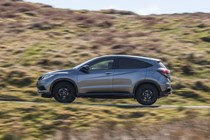
.jpg)

.jpg)
.jpg)
.jpg)
.jpg)
.jpg)
.jpg)
.jpg)
.jpg)
.jpg)
.jpg)
.jpg)
.jpg)
.jpg)
.jpg)
.jpg)
.jpg)
.jpg)

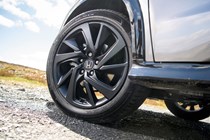
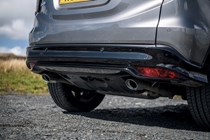
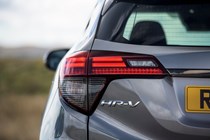
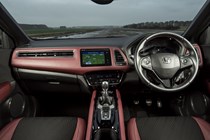

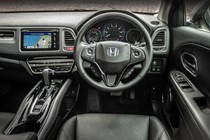
.jpg)
.jpg)
.jpg)
.jpg)
.jpg)
.jpg)
.jpg)
.jpg)
.jpg)
.jpg)
.jpg)
.jpg)
.jpg)
.jpg)
.jpg)
.jpg)
.jpg)
.jpg)
.jpg)
.jpg)
.jpg)
.jpg)
.jpg)
.jpg)
.jpg)
.jpg)
.jpg)
.jpg)
.jpg)
.jpg)
.jpg)
.jpg)
.jpg)
.jpg)
.jpg)
.jpg)
.jpg)
.jpg)
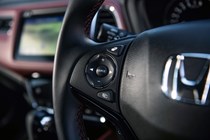
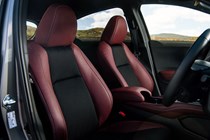
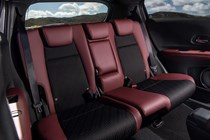


.jpg)
.jpg)
.jpg)
.jpg)
.jpg)
.jpg)
.jpg)
.jpg)
.jpg)
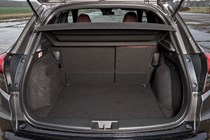
.jpg)
.jpg)
.jpg)
.jpg)
.jpg)
.jpg)
.jpg)
.jpg)
.jpg)
.jpg)

.jpg?quality=50)
.jpg?quality=50)
.jpg?quality=50)
.jpg?quality=50)
.jpg?quality=50)
.jpg?quality=50)
.jpg?quality=50)
.jpg?quality=50)
.jpg?quality=50)
.jpg?quality=50)
.jpg?quality=50)
.jpg?quality=50)
.jpg?quality=50)
.jpg?quality=50)
.jpg?quality=50)
.jpg?quality=50)
.jpg?quality=50)
.jpg?quality=50)
.jpg?quality=50)


.jpg?quality=50)
.jpg?quality=50)
.jpg?quality=50)
.jpg?quality=50)
.jpg?quality=50)
.jpg?quality=50)
.jpg?quality=50)
.jpg?quality=50)

.jpg?quality=50)

.jpg?quality=50)
.jpg?quality=50)
.jpg?quality=50)
.jpg?quality=50)
.jpg?quality=50)
.jpg?quality=50)
.jpg?quality=50)
.jpg?quality=50)
.jpg?quality=50)
.jpg?quality=50)
.jpg?quality=50)
.jpg?quality=50)
.jpg?quality=50)
.jpg?quality=50)
.jpg?quality=50)
.jpg?quality=50)
.jpg?quality=50)







.jpg?quality=50)
.jpg?quality=50)
.jpg?quality=50)
.jpg?quality=50)
.jpg?quality=50)
.jpg?quality=50)
.jpg?quality=50)
.jpg?quality=50)
.jpg?quality=50)
.jpg?quality=50)
.jpg?quality=50)
.jpg?quality=50)
.jpg?quality=50)
.jpg?quality=50)
.jpg?quality=50)
.jpg?quality=50)
.jpg?quality=50)
.jpg?quality=50)
.jpg?quality=50)
.jpg?quality=50)
.jpg?quality=50)
.jpg?quality=50)
.jpg?quality=50)
.jpg?quality=50)
.jpg?quality=50)
.jpg?quality=50)
.jpg?quality=50)
.jpg?quality=50)
.jpg?quality=50)
.jpg?quality=50)
.jpg?quality=50)
.jpg?quality=50)
.jpg?quality=50)
.jpg?quality=50)
.jpg?quality=50)
.jpg?quality=50)
.jpg?quality=50)
.jpg?quality=50)





.jpg?quality=50)
.jpg?quality=50)
.jpg?quality=50)
.jpg?quality=50)
.jpg?quality=50)
.jpg?quality=50)
.jpg?quality=50)
.jpg?quality=50)
.jpg?quality=50)

.jpg?quality=50)
.jpg?quality=50)
.jpg?quality=50)
.jpg?quality=50)
.jpg?quality=50)
.jpg?quality=50)
.jpg?quality=50)
.jpg?quality=50)
.jpg?quality=50)
.jpg?quality=50)